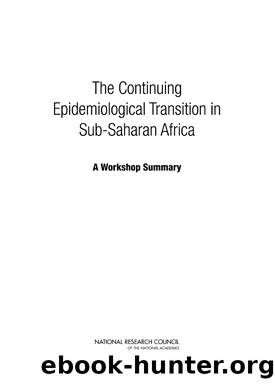The Continuing Epidemiological Transition in Sub-Saharan Africa: A Workshop Summary by Thomas J. Plewes

Author:Thomas J. Plewes
Language: eng
Format: epub
Tags: ebook, book
Publisher: The National Academies Press
Published: 2012-12-17T00:00:00+00:00
7
Data Collection and Validation in Resource-Poor Settings
Much of the input to the workshop emphasized the point that patterns of morbidity and mortality are shifting both in terms of cause and in terms of age distribution. The workshop paper by Byass, de Savigny, and Lopez notes that changing therapeutic options tend to increase prevalence as compared with incidence for some key diseases; perhaps the most obvious example of this phenomenon in sub-Saharan Africa can be found in the use of antiretroviral therapy against HIV/AIDS, which keep AIDS patients alive for longer periods of time, thus increasing rates of prevalence. Changing patterns of risk factorsâsuch as the prevalence of mosquito breeding sites in the case of infectious diseases, or factors such as tobacco and alcohol consumption in the case of noncommunicable diseasesâconstitute a further critical factor in the changing patterns of mortality and morbidity (Dalal et al., 2011; Danaei et al., 2011). All of these factors are changing rapidly against a background of sparse and sometimes dubious detailed information about what is actually happening, which makes it even more vital to proactively consider changes in health data systems in sub-Saharan Africa in order to increase the visibility of the continentâs long-term trends and needs in population health (Byass, 2009).
Nevertheless, it is unrealistic to suppose that over the next 10 to 20 years all the countries of sub-Saharan Africa will develop national health information systems that have sufficiently high coverage and achieve global standards of timeliness, completeness, and quality. Thus it is necessary to consider a transitional approach to improving the supply of health information in the short term in ways that are relevant to the essential policy actions that sub-Saharan African countries will need to take as the epidemiological transition unfolds.
In his presentation for the session on data collection and validation, Peter Byass identified several key questions that countries and international agencies should consider:
⢠What mix of national and local-area data sources are needed for monitoring epidemiological transition, and with what sampling approaches?
⢠How can continuous longitudinal, repeated cross-sectional, and one-time survey data be effectively integrated within a national information system to reveal epidemiological transitions?
⢠What are the economic and human resource implications for upgrading national health information systems in order to measure epidemiological transitions?
⢠What are the ethical and political issues related to long-term improvements in national health information systems?
Byass, de Savigny, and Lopez also described a typology of data sources that can potentially contribute to national health information (see Table 7-1).
TABLE 7-1 Typology of Data Sources That Potentially Contribute to National Health Information
Download
This site does not store any files on its server. We only index and link to content provided by other sites. Please contact the content providers to delete copyright contents if any and email us, we'll remove relevant links or contents immediately.
| Administration & Medicine Economics | Allied Health Professions |
| Basic Sciences | Dentistry |
| History | Medical Informatics |
| Medicine | Nursing |
| Pharmacology | Psychology |
| Research | Veterinary Medicine |
Periodization Training for Sports by Tudor Bompa(7946)
Why We Sleep: Unlocking the Power of Sleep and Dreams by Matthew Walker(6386)
Paper Towns by Green John(4826)
The Immortal Life of Henrietta Lacks by Rebecca Skloot(4274)
The Sports Rules Book by Human Kinetics(4097)
Dynamic Alignment Through Imagery by Eric Franklin(3935)
ACSM's Complete Guide to Fitness & Health by ACSM(3834)
Kaplan MCAT Organic Chemistry Review: Created for MCAT 2015 (Kaplan Test Prep) by Kaplan(3815)
Introduction to Kinesiology by Shirl J. Hoffman(3634)
Livewired by David Eagleman(3547)
The River of Consciousness by Oliver Sacks(3431)
The Death of the Heart by Elizabeth Bowen(3355)
Alchemy and Alchemists by C. J. S. Thompson(3312)
Descartes' Error by Antonio Damasio(3170)
Bad Pharma by Ben Goldacre(3118)
The Gene: An Intimate History by Siddhartha Mukherjee(2942)
The Emperor of All Maladies: A Biography of Cancer by Siddhartha Mukherjee(2942)
The Fate of Rome: Climate, Disease, and the End of an Empire (The Princeton History of the Ancient World) by Kyle Harper(2893)
Kaplan MCAT Behavioral Sciences Review: Created for MCAT 2015 (Kaplan Test Prep) by Kaplan(2832)
